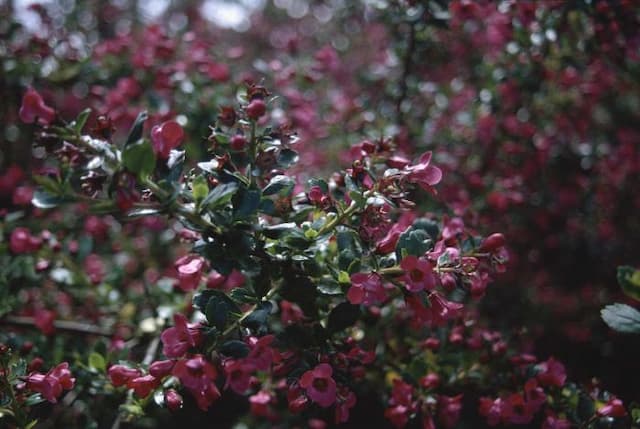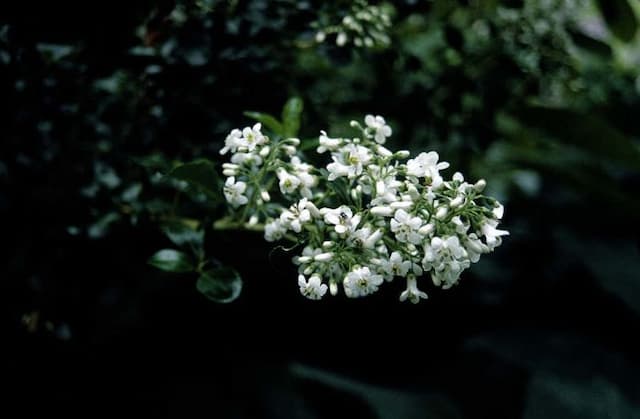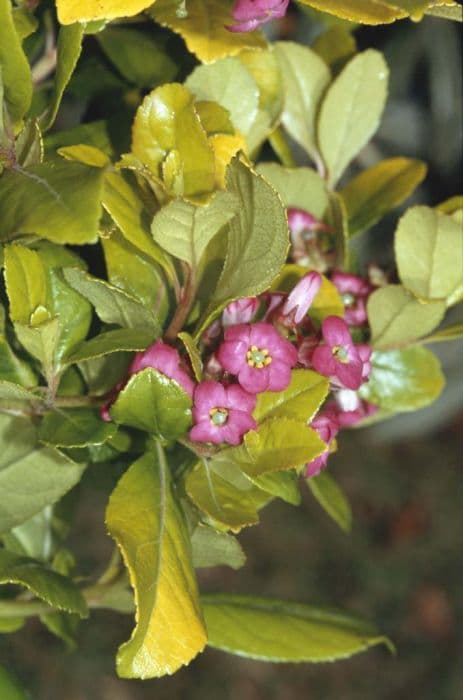Red Escallonia Escallonia rubra 'Crimson Spire'

ABOUT
The Escallonia 'Crimson Spire' is a vibrant, evergreen shrub known for its striking deep red flowers. The plant boasts a dense, bushy habit with glossy, dark green leaves that provide a lush backdrop for the crimson blooms. These flowers appear in abundance, clustered together in conical or raceme-like inflorescences that add a splash of bold color to the garden. The petals of each flower are small, tubular, and attract a range of pollinators, such as bees and butterflies, which find the flowers irresistible. The contrast between the shiny foliage and the bright flowers makes this plant a standout among garden shrubs. In addition to its aesthetic appeal, the Escallonia 'Crimson Spire' emits a light fragrance, which adds another layer of sensory enjoyment to the garden setting. With its resilient nature, this plant is a favorite among gardeners looking to create a vibrant, year-round display of color and texture.
About this plant
 Names
NamesSynonyms
Red Escallonia, Crimson Spire
Common names
Escallonia rubra 'Crimson Spire'.
 Toxicity
ToxicityTo humans
The Crimson Spire Escallonia is not commonly listed as a poisonous plant to humans. However, as with many plants, it is advisable to avoid ingestion, as any non-edible plant material can cause a negative reaction in certain individuals. There is limited information available on the specific symptoms of poisoning for this plant, but ingestion of non-food plants can sometimes result in gastrointestinal discomfort, such as nausea, vomiting, or diarrhea. If you suspect ingestion and are experiencing adverse symptoms, it is recommended to seek medical attention.
To pets
The Crimson Spire Escallonia is not commonly listed as a toxic plant to pets such as dogs and cats. Nevertheless, it is always best to prevent pets from ingesting plants that are not intended for consumption. If a pet ingests a part of this plant, watch for signs of possible gastrointestinal upset including vomiting or diarrhea. If any adverse symptoms occur, it is advisable to contact a veterinarian.
 Characteristics
CharacteristicsLife cycle
Perennials
Foliage type
Evergreen
Color of leaves
Green
Flower color
Crimson
Height
6-9 feet (1.8-2.7 meters)
Spread
4-6 feet (1.2-1.8 meters)
Plant type
Shrub
Hardiness zones
8
Native area
South America
Benefits
 General Benefits
General Benefits- Attracts Pollinators: Escallonia rubra 'Crimson Spire' provides nectar and pollen for bees and other pollinating insects.
- Ornamental Appeal: It has vibrant crimson flowers and shiny evergreen foliage, making it an attractive addition to gardens and landscapes.
- Privacy Screening: With its dense, bushy growth habit, it can be used to create hedges or privacy screens.
- Windbreak Potential: Its sturdy nature allows it to serve as a windbreak, protecting gardens and outdoor spaces.
- Tolerance to Conditions: It is tolerant of seaside conditions, which makes it suitable for coastal gardens.
- Low Maintenance: Requires minimal pruning and care once established, which is ideal for gardeners of all levels.
- Drought Resistance: Once established, the plant can tolerate periods of drought, reducing the need for frequent watering.
- Pest Resistance: The plant is relatively resistant to pests and diseases, ensuring its longevity and ease of care.
 Medical Properties
Medical PropertiesThis plant is not used for medical purposes.
 Air-purifying Qualities
Air-purifying QualitiesThis plant is not specifically known for air purifying qualities.
 Other Uses
Other Uses- Escallonia rubra 'Crimson Spire', commonly known as escallonia, can be used as a natural windbreak in coastal areas, due to its hardiness and dense growth habit.
- The plant's dense foliage can provide privacy screening in gardens and residential areas, making it a natural alternative to fencing or man-made barriers.
- Escallonia can be shaped into topiary forms for decorative purposes in formal gardens, where its evergreen nature maintains year-round interest.
- The plant is effective at providing erosion control on slopes and banks, as its fibrous root system helps to stabilize the soil.
- When grown in large quantities, escallonia can serve as a habitat for beneficial insects and birds, supporting local biodiversity.
- Its hardy nature makes escallonia suitable for urban landscaping projects, where pollution tolerance is as important as aesthetic appeal.
- Due to its quick growth rate, escallonia can be used in reforestation efforts or as a pioneer plant in disturbed areas to initiate ecological recovery.
- The colorful flowers of escallonia attract pollinators, making it a functional plant in vegetable gardens and orchards to enhance pollination of crops.
- Escallonia can be dried and used in decorative wreaths and floral arrangements, offering a touch of greenery to crafts and home decor.
- In coastal-themed gardens, the escallonia's salt tolerance and dense growth pattern enable it to serve as a thematic planting that's both practical and aesthetically in tune with seaside environments.
Interesting Facts
 Feng Shui
Feng ShuiThe Escallonia is not used in Feng Shui practice.
 Zodiac Sign Compitability
Zodiac Sign CompitabilityThe Escallonia is not used in astrology practice.
 Plant Symbolism
Plant Symbolism- Protection: Escallonia plants have dense foliage and are often used as protective hedges, symbolizing shelter and defense against adversity.
- Endurance: Known for their hardiness, escallonias can withstand tough conditions, representing resilience and the ability to endure challenges.
- Boundaries: As a hedge plant, the Escallonia rubra 'Crimson Spire' is commonly used to mark property lines, symbolizing the setting and respecting of boundaries.
- Love and Attraction: The 'Crimson Spire's' red flowers are associated with passion and desire, making it a symbol of love and magnetic attraction.
- Beauty: The striking appearance of its crimson blooms signifies beauty and admiration, inviting a sense of awe and wonder in the garden.
 Water
WaterCrimson Spire should be watered deeply, ensuring that the water reaches the roots, but allowing the soil to dry slightly between waterings. Generally, this shrub requires watering every 7 to 10 days, depending on the weather conditions and soil drainage. In hotter, drier periods, it may need water more frequently, especially if it is in a location with full sun exposure. It's recommended to provide about 1 to 1.5 gallons of water each time for an established plant to maintain proper soil moisture. Overwatering can lead to root rot, so it is crucial to avoid saturating the soil consistently.
 Light
LightEscallonia rubra 'Crimson Spire' flourishes best in full sun to partial shade conditions. It should receive at least 6 hours of direct sunlight each day for optimal growth and flowering. An ideal spot would be one where it is exposed to the morning sun but protected from the intense heat of the afternoon, especially in hotter climates.
 Temperature
TemperatureCrimson Spire escallonias are hardy and can withstand a range of temperatures, but they thrive in a temperature range of 50°F to 75°F. They can tolerate temperatures down to about 10°F, though they may suffer some foliage damage. This shrub does well in moderate climates without extreme cold or heat and should be protected from severe freezes.
 Pruning
PruningPruning Crimson Spire is important for maintaining its shape and encouraging healthy growth and blooms. Light pruning can be done any time of year to remove dead or damaged branches, but the best time for more extensive shaping is in late winter or early spring before new growth starts. This plant benefits from an annual pruning in which one-third of the oldest stems are cut back to the ground to promote new growth.
 Cleaning
CleaningAs needed
 Soil
SoilThe best soil mix for Escallonia (Red Escallonia) is one that is well-draining with a mix of loam, peat, sand, and compost to retain moderate moisture. Ideally, the soil pH should be slightly acidic to neutral, ranging from 5.5 to 7.0.
 Repotting
RepottingRed Escallonia generally does not require frequent repotting. It can be repotted every 2-3 years, or as necessary when the plant outgrows its current container.
 Humidity & Misting
Humidity & MistingRed Escallonia prefers moderate humidity but is quite adaptable. It thrives outdoors where it can generally tolerate the natural humidity levels of its environment.
 Suitable locations
Suitable locationsIndoor
Place in bright, indirect light; ensure good airflow.
Outdoor
Plant in sunny spot, shelter from strong winds, well-drained soil.
Hardiness zone
8-10 USDA
 Life cycle
Life cycleThe life of Escallonia rubra 'Crimson Spire', commonly known as Red Escallonia, begins with seed germination, where environmental conditions like warmth and moisture stimulate the seed to sprout roots and shoots. This is followed by the seedling stage, during which the first leaves develop and photosynthesis enables further growth. As the plant enters the vegetative stage, it experiences rapid growth by developing a robust root system, stems, and foliage. Throughout the growing seasons, the Red Escallonia progresses to the flowering stage, producing vibrant red, tubular flowers that attract pollinators such as bees and butterflies. After pollination, the plant produces seeds, completing the sexual reproduction cycle. Finally, in the maturity stage, the Red Escallonia maintains its size and may have periods of dormancy during colder seasons, with its life span potentially reaching several years before it eventually senesces and dies.
 Propogation
PropogationPropogation time
Late spring to early summer
The most popular method of propagation for the Crimson Spire, a variety of Escallonia rubra, is through semi-hardwood cuttings. The best time to propagate is typically in late summer when the new growth has begun to mature and harden slightly. To do this, one would take cuttings of about 4 to 6 inches (approximately 10 to 15 centimeters) from healthy, disease-free branches. The leaves on the lower half of the cutting should be removed, and the cut end dipped in a rooting hormone to enhance root development. The cutting should then be placed into a pot with a mix of peat and perlite, ensuring that the soil remains moist but not waterlogged. It is helpful to cover the pot with a plastic bag to retain humidity until the cutting has rooted, which generally takes a few weeks to a month. Once rooted, the new plant can be hardened off and eventually transplanted outdoors.


![Escallonia [Golden Carpet]](/_next/image?url=https%3A%2F%2Fplants-admin.emdemapps.com%2Fimages%2Fplants%2F%2Fimages%2F604b59284be41.png&w=640&q=75)


![Escallonia [Pink Elle]](/_next/image?url=https%3A%2F%2Fplants-admin.emdemapps.com%2Fimages%2Fplants%2F%2Fimages%2F604b630962bc2.png&w=640&q=75)



